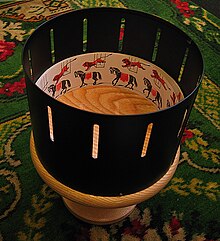zoetrope
Appearance
English
[edit]
Etymology
[edit]From Ancient Greek ζωή (zōḗ, “life”) + -trope. Coined by inventor William E. Lincoln.
Pronunciation
[edit]- IPA(key): /ˈzəʊɪtɹəʊp/
Audio (Southern England): (file)
Noun
[edit]zoetrope (plural zoetropes)
- An optical toy, in which figures made to revolve on the inside of a cylinder, and viewed through slits in its circumference, appear like a single figure passing through a series of natural motions as if animated or mechanically moved.
- 1890, William James, The principles of psychology[1], page 200:
- Is consciousness really discontinuous, incessantly interrupted and recommencing (from the psychologist’s point of view)? and does it only seem continuous to itself by an illusion analogous to that of the zoetrope?
- 1993, Will Self, My Idea of Fun:
- This was the way I passed through the remainder of my childhood. The zoetrope span smoothly, time’s Chief Designer narrowed the legs of trousers and decreed that the cars should be more aerodynamic.
- 2014 April 11, Ron Charles, “David Grand’s ‘Mount Terminus’”, in The Guardian Weekly, volume 190, number 18, page 37:
- The Rosenbloom Loop is a clever little device, but it’s an even more clever symbol of the role that discipline plays in the creation of illusion: the persistence of vision that makes sequential still images appear to move. In a sense, that’s the wizardry that Grand spins in this zoetrope of a novel as these characters love and build and pine and die.
Synonyms
[edit]Translations
[edit]optical toy

